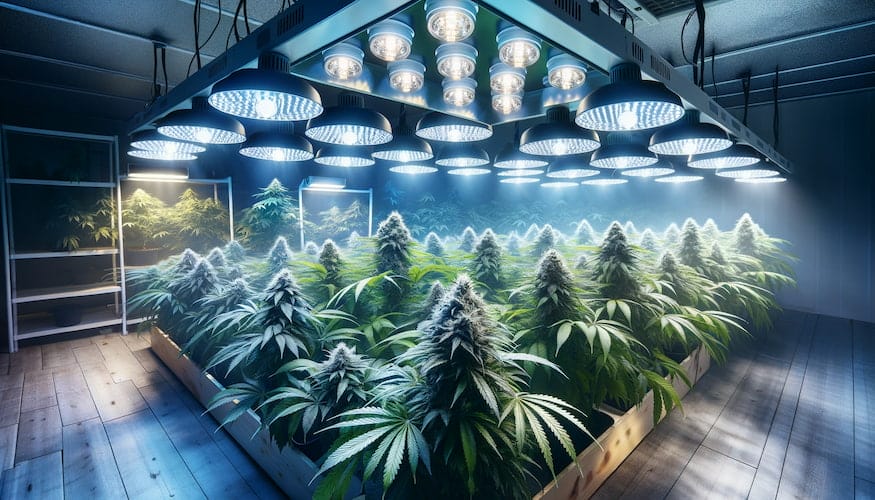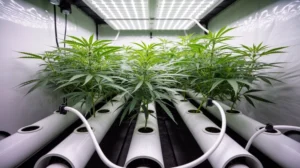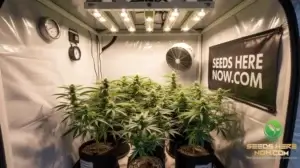LED vs MH Grow Lights for Cannabis


Choosing the right grow lights represents one of the most critical decisions in cannabis cultivation, directly impacting everything from your electricity bills to your final harvest quality. This comprehensive comparison of LED vs MH grow lights for cannabis will provide you with the expert knowledge needed to make an informed decision that maximizes both your yields and your return on investment.
As indoor cannabis cultivation continues to evolve rapidly, understanding the fundamental differences between LED and metal halide (MH) lighting systems has become essential for serious growers. The lighting system you choose will influence not only your plants’ growth patterns and final yields but also your operational costs, safety considerations, and long-term cultivation success.
In this detailed analysis, we’ll explore the importance of light in cannabis cultivation and how different lighting technologies impact every aspect of plant development. From energy efficiency and spectrum customization to heat management and long-term costs, we’ll examine every factor that matters to today’s cannabis cultivators.
Key Takeaways:
- LED grow lights offer superior energy efficiency, consuming up to 70% less electricity than MH systems while producing comparable or higher yields
- Metal halide lights provide excellent value for budget-conscious growers with lower upfront costs and proven vegetative growth performance
- LED technology delivers precise spectrum control and significantly lower heat generation, reducing cooling requirements and operational complexity
- MH lights excel in promoting robust vegetative growth but require additional ventilation and consume substantially more energy
- Long-term cost analysis favors LED systems despite higher initial investment due to energy savings and extended lifespan
- Safety considerations strongly favor LED technology with reduced fire risk and lower heat-related plant stress
The Critical Role of Light in Cannabis Cultivation Success
Light serves as the fundamental energy source driving photosynthesis in cannabis plants, making it the single most important environmental factor in determining cultivation success. While outdoor cannabis plants naturally harness the sun’s full spectrum energy, indoor cultivators must recreate these optimal conditions using artificial lighting systems. The quality, intensity, and spectrum of your chosen lighting directly influence every aspect of plant development, from initial seedling vigor to final cannabinoid and terpene production.
During the vegetative stage, cannabis plants require blue light wavelengths (400-500nm) to stimulate chlorophyll production, promote robust leaf development, and encourage strong stem formation. This blue-rich spectrum triggers the physiological processes that create the foundational structure necessary for supporting heavy flower development later in the growth cycle.
As plants transition to flowering, their light requirements shift dramatically toward red wavelengths (600-700nm), which trigger hormonal changes that initiate bud formation and promote the biosynthesis of cannabinoids and terpenes. The quality and consistency of light during this critical phase directly determines not only yield quantity but also the potency, flavor profile, and overall quality of your final harvest.
Modern lighting technologies have evolved to provide unprecedented control over these spectral requirements, allowing cultivators to optimize their light environments for maximum productivity. Understanding how different lighting systems deliver these essential wavelengths forms the foundation for making an informed choice between LED and MH technologies.
LED Grow Lights: The Future of Cannabis Cultivation
LED grow lights represent the cutting edge of horticultural lighting technology, offering cannabis cultivators unprecedented control over their growing environments. These advanced lighting systems utilize light-emitting diodes to produce precise wavelengths of light with remarkable efficiency, making them increasingly popular among professional indoor cultivation operations worldwide.
The revolutionary design of LED systems allows manufacturers to engineer specific light recipes tailored to different stages of cannabis development. Unlike broad-spectrum lighting that wastes energy on wavelengths plants cannot utilize, LEDs focus their energy output on the photosynthetically active radiation (PAR) that plants actually use for growth and development.
Advanced LED Technology Benefits for Cannabis Growers
Modern LED grow lights deliver exceptional energy efficiency, typically consuming 40-70% less electricity than comparable metal halide systems while producing equal or superior growing results. This dramatic reduction in energy consumption translates directly to lower operational costs and improved profit margins for commercial operations.
The precise spectrum control offered by quality LED systems enables growers to customize their light output for specific cultivars and growth stages. Advanced LED controllers allow real-time adjustment of light intensity and spectrum composition, providing the flexibility to optimize conditions throughout the entire growth cycle.
Heat management represents another significant advantage of LED technology. Unlike metal halide systems that convert substantial energy into waste heat, LEDs operate at much cooler temperatures, reducing stress on plants and minimizing the need for extensive cooling systems. This improved thermal efficiency creates more stable growing environments and reduces the risk of heat-related plant problems.
Quality LED systems from reputable manufacturers offer exceptional longevity, typically operating effectively for 50,000-100,000 hours compared to the 10,000-20,000 hour lifespan of metal halide bulbs. This extended operational life significantly reduces replacement costs and maintenance requirements over the system’s lifetime.
Metal Halide (MH) Grow Lights: Proven Performance for Cannabis
Metal halide grow lights have established themselves as a trusted and reliable choice for cannabis cultivation, particularly excelling during the vegetative growth phase. These high-intensity discharge (HID) lamps produce a cool, blue-white light spectrum that closely mimics natural sunlight, making them especially effective for promoting healthy leaf development and robust vegetative growth.
MH technology operates by creating an electrical arc through a mixture of mercury and metal halide compounds, producing intense light output with excellent penetration characteristics. This deep light penetration makes MH systems particularly effective for larger plants and multi-level growing operations where light needs to reach lower canopy areas.
Key Advantages of Metal Halide Systems
The primary advantage of MH grow lights lies in their versatility across both vegetative and flowering stages of cannabis development. While specialized for vegetative growth, quality MH systems can successfully support plants throughout their entire lifecycle when paired with appropriate supplemental lighting during flowering.
Cost accessibility represents another significant benefit of MH technology. Initial system costs typically run 50-70% lower than comparable LED setups, making MH lights attractive for new growers or those operating with limited startup budgets. This lower barrier to entry has made MH systems the gateway technology for countless successful cannabis cultivators.
Wide availability and established supply chains ensure that MH bulbs, ballasts, and replacement parts remain readily accessible through numerous suppliers. This accessibility provides growers with confidence in long-term system support and competitive pricing on replacement components.
| MH Advantages | Applications |
|---|---|
| Excellent vegetative growth promotion | Ideal for mother plant maintenance and clone development |
| Lower initial investment costs | Perfect for budget-conscious new growers and small operations |
| Deep light penetration | Effective for larger plants and multi-tier growing systems |
| Proven track record | Decades of successful commercial cannabis cultivation |
| Wide availability | Easy sourcing of replacement bulbs and system components |
Comprehensive LED vs MH Performance Comparison
Understanding the practical differences between LED and MH grow lights requires examining their performance across multiple critical factors that impact both growing success and operational efficiency. This detailed analysis will help you evaluate which technology best suits your specific cultivation goals, budget constraints, and operational requirements.
LED Grow Lights: Advantages and Considerations
LED Advantages:
- Superior Energy Efficiency: Consume 40-70% less electricity than MH systems, dramatically reducing operational costs and environmental impact
- Precise Spectrum Control: Customizable light recipes optimize plant development at each growth stage, potentially increasing yields by 15-25%
- Extended Lifespan: 50,000-100,000 hour operational life reduces replacement costs and maintenance downtime
- Minimal Heat Generation: Lower operating temperatures reduce cooling requirements and create more stable growing environments
- Compact Design: Space-efficient form factors maximize growing area utilization
- Instant On/Off: No warm-up period required, enabling precise lighting schedules and energy savings
LED Considerations:
- Higher Initial Investment: Quality LED systems require 2-3x the upfront cost of comparable MH setups
- Quality Variations: Significant performance differences between manufacturers require careful brand selection
- Technology Learning Curve: Advanced features may require education for optimal utilization
Metal Halide Grow Lights: Advantages and Considerations
MH Advantages:
- Lower Initial Costs: Significantly reduced upfront investment makes MH accessible for budget-conscious growers
- Proven Performance: Decades of successful cannabis cultivation demonstrate reliable growing results
- Deep Light Penetration: High-intensity output effectively illuminates lower canopy areas
- Simple Operation: Straightforward setup and operation with minimal learning curve
- Wide Availability: Easy sourcing of replacement bulbs and components from multiple suppliers
MH Considerations:
- High Energy Consumption: Significantly higher electricity costs impact long-term operational expenses
- Substantial Heat Production: Requires extensive ventilation and cooling systems
- Shorter Lifespan: Frequent bulb replacements increase maintenance costs and labor
- Limited Spectrum Control: Fixed light output reduces optimization opportunities
- Safety Concerns: Higher fire risk and potential for heat damage to plants
| Performance Factor | LED Grow Lights | MH Grow Lights |
|---|---|---|
| Energy Efficiency | Excellent – 40-70% energy savings | Poor – High energy consumption |
| Spectrum Customization | Excellent – Full spectrum control | Limited – Fixed spectrum output |
| Operational Lifespan | Excellent – 50,000+ hours | Fair – 10,000-20,000 hours |
| Initial Investment | High – Premium upfront cost | Low – Budget-friendly entry point |
| Heat Generation | Low – Minimal cooling required | High – Extensive cooling necessary |
| Maintenance Requirements | Low – Infrequent component replacement | High – Regular bulb replacements |
Cost Analysis and Long-Term Financial Impact
Making an informed decision between LED and MH grow lights requires understanding the complete financial picture, including initial costs, operational expenses, and long-term return on investment. While upfront costs often dominate purchasing decisions, the total cost of ownership over a system’s lifetime tells a dramatically different story.
5-Year Total Cost of Ownership Analysis
LED System Example (600W equivalent coverage):
- Initial LED system cost: $800-1,200
- Annual electricity cost (12 hours/day): $315
- Replacement costs over 5 years: $0-200
- 5-year total cost: $2,375-2,775
MH System Example (600W coverage):
- Initial MH system cost: $300-500
- Annual electricity cost (12 hours/day): $525
- Bulb replacements over 5 years: $300-500
- Additional cooling costs: $200-400/year
- 5-year total cost: $3,925-5,125
This analysis reveals that despite higher initial costs, LED systems typically provide 30-40% lower total cost of ownership over their operational lifetime. The energy efficiency advantages of LED technology compound over time, with savings becoming more pronounced as electricity rates increase and as systems operate for longer periods.
For commercial operations running multiple lights continuously, these savings multiply dramatically. A 20-light operation switching from MH to LED technology could save $15,000-25,000 annually in operational costs while improving growing conditions and reducing maintenance requirements.
Energy Consumption Breakdown
LED grow lights achieve their energy efficiency through superior photon conversion rates, converting approximately 40-50% of input energy into usable light compared to 15-25% for metal halide systems. This fundamental efficiency difference means LED systems produce the same photosynthetic photon flux density (PPFD) using significantly less electricity.
Additionally, the reduced heat output of LED systems eliminates much of the cooling energy required by MH operations. In warm climates or poorly ventilated spaces, cooling costs can represent 30-50% of total growing operation energy consumption, making this secondary benefit extremely valuable.
Setup Complexity and Ease of Use Comparison
The ease of installation and operation represents a crucial factor for many growers, particularly those new to indoor cultivation or operating in space-constrained environments. Both LED and MH systems offer distinct advantages in different aspects of setup and ongoing operation.
LED System Installation and Operation
Modern LED grow lights emphasize user-friendly design with plug-and-play functionality that eliminates many of the complications associated with traditional lighting systems. Most quality LED units arrive ready for immediate use, requiring only mounting and electrical connection to begin operation.
The absence of ballast requirements significantly simplifies LED installations, reducing component count, potential failure points, and electrical complexity. Many LED systems feature integrated drivers and cooling systems, creating clean, compact installations that maximize growing space utilization.
Advanced LED controllers offer smartphone connectivity and programmable lighting schedules, allowing growers to optimize their light cycles remotely and track system performance over time. This technological integration provides unprecedented control over growing environments while simplifying day-to-day operations.
MH System Installation and Operation
Metal halide systems require ballasts for proper operation, adding complexity to initial setup and creating additional components that require mounting and electrical connections. However, this traditional design has created widespread familiarity among growers and extensive technical support resources.
The higher heat output of MH systems necessitates careful ventilation planning and may require additional cooling equipment, particularly in smaller growing spaces or warmer climates. Proper air circulation becomes critical for maintaining optimal growing temperatures and preventing heat stress on plants.
| Setup Factor | LED Grow Lights | MH Grow Lights |
|---|---|---|
| Installation Complexity | Simple – Plug-and-play design | Moderate – Requires ballast installation |
| Space Requirements | Compact – Minimal space impact | Larger – Ballast and cooling space needed |
| Ventilation Needs | Minimal – Low heat production | Extensive – High heat requires cooling |
| Control Options | Advanced – Digital controls and scheduling | Basic – Manual timers and switches |
| Maintenance Frequency | Low – Infrequent component replacement | High – Regular bulb and ballast maintenance |
Yield Performance and Quality Comparison
Ultimately, the success of any lighting system must be measured by its ability to produce high-quality cannabis in substantial quantities. Both LED and MH systems can produce excellent results, but they achieve these outcomes through different mechanisms and may excel in different aspects of plant development.
LED Yield Performance
Advanced LED systems consistently demonstrate their ability to match or exceed the yields produced by traditional MH lighting while often improving the quality characteristics of the final harvest. The precise spectrum control offered by LED technology allows growers to optimize light conditions for specific cultivars and growth stages, potentially increasing yields by 15-25% compared to fixed-spectrum alternatives.
LED systems excel at promoting dense node development and compact internodal spacing, characteristics that typically correlate with higher flower production per plant. The ability to adjust light intensity and spectrum throughout the growth cycle enables growers to maximize vegetative development while promoting exceptional flower formation during the bloom phase.
Quality improvements under LED lighting often include enhanced cannabinoid production, improved terpene profiles, and better overall flower structure. Many cultivators report that LED-grown cannabis exhibits superior bag appeal with denser buds, more vibrant colors, and enhanced resin production.
MH Yield Performance
Metal halide systems have earned their reputation through decades of successful commercial cannabis production, consistently delivering reliable yields with proven growing techniques. MH lights excel at promoting vigorous vegetative growth, creating the strong plant structure necessary for supporting heavy flower development.
The deep penetration characteristics of MH lighting make these systems particularly effective for larger plants and multi-level growing operations where light needs to reach lower canopy areas. This penetration advantage can result in more uniform bud development throughout the plant structure.
While MH systems may not match the peak yields achievable with optimized LED setups, they consistently produce satisfactory results that justify their continued popularity among budget-conscious growers and those preferring traditional cultivation methods.
| Yield Factor | LED Performance | MH Performance |
|---|---|---|
| Yield Potential | Excellent – Often 15-25% higher yields | Good – Reliable, consistent production |
| Cannabinoid Production | Enhanced – Optimized spectrum promotes potency | Standard – Proven reliable production |
| Terpene Development | Superior – Enhanced flavor and aroma profiles | Good – Traditional flavor development |
| Bud Density | Excellent – Compact, dense flower structure | Good – Solid bud development |
| Plant Structure | Optimized – Controlled internodal spacing | Robust – Strong vegetative development |
Safety Considerations and Risk Management
Safety represents a critical factor in cannabis cultivation operations, with lighting systems presenting both fire risks and potential for plant damage through excessive heat generation. Understanding and mitigating these risks protects both your investment and your personal safety.
Critical Safety Advantages of LED Technology
LED grow lights offer substantial safety advantages over metal halide systems, primarily through their dramatically reduced heat generation. Operating temperatures of LED fixtures typically remain 50-100°F cooler than comparable MH systems, virtually eliminating the risk of heat-related fires and significantly reducing plant stress from excessive temperatures.
The lower voltage requirements of many LED systems reduce electrical hazards, while the absence of high-pressure mercury vapor bulbs eliminates the risk of explosive bulb failure that can occur with aging MH lamps. Additionally, LED systems contain no toxic materials, making disposal and replacement safer for both growers and the environment.
MH Safety Considerations
Metal halide systems require careful attention to safety protocols due to their high heat output and electrical requirements. Proper ventilation becomes essential not only for plant health but also for fire prevention, as MH systems can create dangerous hot spots in poorly ventilated spaces.
The high-pressure mercury vapor bulbs used in MH systems can explode if damaged or at the end of their operational life, creating both safety hazards and potential contamination issues. Proper handling procedures and protective equipment become necessary when replacing MH bulbs.
Electrical safety requires special attention with MH systems due to their higher amperage requirements and the additional complexity introduced by ballast systems. Proper electrical installation and regular maintenance help prevent dangerous electrical faults that could result in fires or electrocution.
Temperature Management and Plant Health
Excessive heat from lighting systems can cause numerous plant health problems, including heat stress, nutrient uptake issues, and increased susceptibility to pests and diseases. Temperature control becomes crucial for maintaining optimal growing conditions throughout the cultivation cycle.
LED systems’ lower heat output creates more stable growing environments with reduced temperature fluctuations, allowing for more precise environmental control and reducing the stress on plants. This thermal stability often translates to healthier plants, improved yields, and reduced risk of cultivation problems.
Making the Right Choice for Your Cannabis Operation
Selecting between LED and MH grow lights requires careful evaluation of your specific growing situation, budget constraints, and long-term cultivation goals. Both technologies offer viable paths to successful cannabis cultivation, but they excel in different scenarios and serve different types of growers.
LED Systems Are Ideal For:
- Energy-conscious growers: Operations prioritizing long-term cost savings and environmental sustainability
- Precision cultivators: Growers seeking maximum control over plant development and quality
- Space-limited operations: Setups where compact design and minimal heat generation provide significant advantages
- Commercial producers: Large-scale operations where energy savings and reduced maintenance justify higher initial investment
- Quality-focused growers: Cultivators prioritizing maximum cannabinoid and terpene production
MH Systems Are Ideal For:
- Budget-conscious beginners: New growers with limited startup capital but requiring proven performance
- Traditional cultivators: Experienced growers comfortable with established HID technology
- Large plant operations: Setups requiring deep light penetration for bigger plants
- Short-term operations: Temporary or seasonal growing operations where tighter budgets prioritize low initial costs
- Supplemental lighting: Operations using MH lights to complement existing lighting systems
Conclusion
The choice between LED and MH grow lights ultimately depends on your specific cultivation goals, budget constraints, and operational priorities. LED technology offers superior energy efficiency, precise spectrum control, and enhanced safety features that make it the preferred choice for most modern cannabis operations. While the higher initial investment may seem daunting, the long-term benefits of reduced operating costs, improved yields, and enhanced quality typically justify the upfront expense.
Metal halide systems remain a viable option for budget-conscious growers and those comfortable with traditional HID technology. Their lower initial costs and proven performance record continue to make them attractive for certain applications, particularly for growers prioritizing immediate cost savings over long-term efficiency.
As the cannabis industry continues to evolve toward more sustainable and efficient cultivation practices, LED technology represents the clear direction for future development. However, successful cultivation depends more on understanding and optimizing your chosen lighting system than on the specific technology itself. Whether you choose LED or MH lighting, consistent application of proper growing techniques and attention to plant needs will determine your ultimate success.
FAQ
Are LED grow lights better than MH grow lights for cannabis cultivation?
LED grow lights offer superior energy efficiency, spectrum control, and safety advantages, making them better for most modern cannabis operations. However, MH lights remain viable for budget-conscious growers and specific applications requiring deep light penetration. The choice depends on your specific needs, budget, and long-term goals.
Do LED grow lights consume less energy than MH grow lights?
Yes, LED grow lights typically consume 40-70% less electricity than MH grow lights while producing the same or better growing results. This dramatic energy reduction translates to significantly lower operational costs and improved environmental sustainability.
Are LED grow lights easier to set up and use compared to MH grow lights?
LED grow lights generally offer simpler installation with plug-and-play functionality and no ballast requirements. They also produce less heat, reducing ventilation needs. MH systems require ballasts and more extensive cooling systems, making them more complex to install and operate.
Can LED grow lights produce higher yields than MH grow lights?
LED grow lights consistently produce comparable or higher yields than MH systems, often achieving 15-25% increases through optimized spectrum control and improved growing conditions. However, yield success ultimately depends on overall growing skills and environmental management.
Are LED grow lights safer to use than MH grow lights?
Yes, LED grow lights are significantly safer due to lower heat generation, reduced fire risk, lower voltage requirements, and absence of explosive mercury vapor bulbs. They eliminate many safety concerns associated with traditional HID lighting while creating more stable growing environments.
What is the lifespan difference between LED and MH grow lights?
LED grow lights typically last 50,000-100,000 hours compared to 10,000-20,000 hours for MH bulbs. This 3-5x longer lifespan significantly reduces replacement costs and maintenance requirements, contributing to LED systems’ superior long-term value proposition.
How much money can I save by switching from MH to LED grow lights?
Most growers save 30-40% on total costs over a 5-year period when switching from MH to LED systems. Energy savings alone typically range from $200-400 annually per 600W equivalent light, with additional savings from reduced cooling costs and maintenance requirements.
Which lighting system is better for cannabis quality and potency?
LED grow lights generally produce higher quality cannabis with enhanced cannabinoid production, improved terpene profiles, and better overall flower structure. The precise spectrum control of LED systems allows optimization for specific quality characteristics that MH systems cannot match.
RESPONSES (0)
No responses yet. Be the first to respond!
Suggested Articles
;)
;)
;)




 03 Dec 2025
03 Dec 2025  7 min read
7 min read


 January 22, 2024
January 22, 2024 


RESPONSES (0)
No responses yet. Be the first to respond!